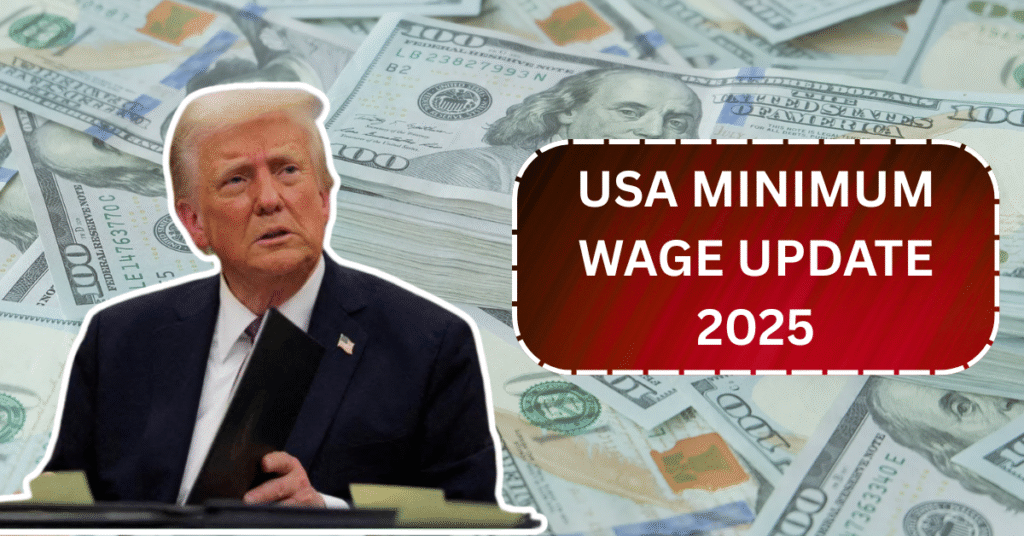The USA minimum wage is a key factor in determining the income for millions of workers across the country. As the cost of living rises, there’s growing pressure for higher wages to ensure that people can keep up with inflation and meet their basic needs. In 2025, the U.S. will experience significant shifts in minimum wage policies as several states introduce increases to their base pay rates.
United States Minimum Wage 2025 Overview
| Department | United States Department of Labor |
| Program | USA Minimum Wage Increase 2025 |
| Recipients | USA workers |
| Current federal minimum wage | $7.25/ hour |
| Highest state min wage (2025) | $15.20 (Washington) |
| Lowest state min wage (2025) | $7.25 (several states) |
| Total States | 30 States+ DC |
| Category | Government Aid |
| Official Website | https://www.dol.gov/ |
What is the Minimum Wage?
The minimum wage is the lowest wage that employers are legally required to pay their workers. In the U.S., there is a federal minimum wage, but individual states, counties, and cities have the power to set their own higher rates, depending on local economic conditions.
The federal minimum wage, which has remained at $7.25 per hour since 2009, serves as a baseline. However, many states and cities have introduced higher minimum wage laws in response to the rising cost of living.
The 2025 Federal Minimum Wage Increase
While the federal minimum wage rate has not changed in over a decade, Congress is discussing increasing it to $15 per hour nationwide. However, there’s no certainty about when or if this will be implemented at the federal level in 2025.
At the federal level, lawmakers are considering proposals to raise the minimum wage. Advocates argue that an increase is necessary to ensure that workers can afford basic living expenses such as housing, healthcare, and food. However, opponents to the rise worry about the impact on small businesses and potential job losses.
Despite the uncertainty at the federal level, many states and cities have already moved forward with increasing their minimum wages.
State-by-State Breakdown of Minimum Wage Increases in 2025
In 2025, multiple states and localities across the U.S. will increase their minimum wages. The exact increase varies by region, with some states introducing scheduled increases over several years. Let’s take a look at the significant changes that are expected in 2025.
1. California
California has long been at the forefront of raising the minimum wage. In 2025, the state will see a significant increase, with the minimum wage rising to $15.50 per hour. This increase is part of a phased approach that was originally passed in 2016.
California’s progressive wage policies aim to support the state’s high cost of living. With cities like San Francisco and Los Angeles facing soaring housing costs, the wage increase will help workers meet their everyday needs.
2. New York
New York is also increasing its minimum wage in 2025. For most areas of the state, the minimum wage will increase to $15.00 per hour, a level that was previously achieved in New York City. However, some upstate regions, where the cost of living is lower, will see slightly smaller increases. The phased increase plan aims to close the gap between different areas of the state.
3. Florida
Florida’s voters approved a significant minimum wage hike in 2020, with the rate increasing by $1 per year until it reaches $15 per hour. By 2025, the minimum wage in Florida will rise to $15 per hour, making it one of the highest in the Southeast U.S. The increase aims to address the affordability challenges faced by workers in major cities like Miami.
4. Washington
In Washington, the minimum wage will also increase in 2025. The state’s minimum wage is one of the highest in the country, currently sitting at $14.49 per hour. In 2025, it is expected to increase to around $15.75 per hour, reflecting the state’s commitment to ensuring a decent standard of living for workers.
5. Oregon
Oregon is known for its high cost of living, particularly in cities like Portland. As such, the state will increase its minimum wage to $15.65 per hour in 2025, one of the highest in the nation. The state’s wage increases are scheduled to match inflation to maintain purchasing power for workers.
6. Colorado
Colorado has also set a path for higher wages, with a minimum wage of $15.00 per hour coming into effect in 2025. This increase is part of the state’s commitment to addressing the growing affordability crisis in Denver and other urban areas. The wage hike is expected to help many workers in industries such as retail, hospitality, and healthcare.
7. Texas
Texas will not see a state-wide increase in its minimum wage in 2025. The state has maintained a minimum wage of $7.25 per hour, in line with the federal standard. However, some cities within Texas, such as Austin and Dallas, are pushing for higher local minimum wages to help combat rising living costs.
8. Arizona
Arizona will see a notable increase in its minimum wage in 2025, reaching $15.00 per hour. The state’s minimum wage hikes are part of a gradual increase plan that voters approved in 2016. This wage adjustment is designed to meet the growing demands of inflation and provide workers with better financial stability.
9. Illinois
In Illinois, the minimum wage will rise to $15.00 per hour in 2025, as part of a phased increase that began in 2020. Chicago, which has one of the highest costs of living in the state, has already surpassed the $15.00 mark, but this increase ensures that workers across the state receive the same wage rate.
10. Michigan
Michigan is another state increasing its minimum wage to $15.00 per hour by 2025. This increase is part of a gradual climb that was enacted by the Michigan legislature in 2018. As the cost of living in Michigan rises, especially in urban areas like Detroit, the wage hike aims to alleviate some of the financial pressures workers are facing.
The Debate: Pros and Cons of the Minimum Wage Increase
The increase in the minimum wage is a topic of ongoing debate. Proponents argue that raising the minimum wage will lift millions of workers out of poverty, improve job satisfaction, and boost the economy by increasing consumer spending. They point to studies that suggest that higher wages can lead to lower turnover rates and greater employee productivity.
On the other hand, critics argue that raising the minimum wage could lead to higher prices for goods and services, potentially reducing employment opportunities for lower-skilled workers. Small businesses, in particular, may struggle to pay higher wages, leading to layoffs or business closures.
Some studies suggest that businesses in high-wage areas like New York or California might absorb the higher wages, while businesses in lower-wage states might face greater challenges. The impact on inflation and employment remains a key concern for economists and policymakers.
Conclusion
The 2025 minimum wage increases across the U.S. represent an important step in addressing income inequality and providing workers with fairer compensation. While the increases vary by state, they reflect a growing recognition of the need for higher wages to keep up with inflation and rising living costs.
As the situation continues to evolve, workers, businesses, and policymakers must remain engaged in discussions about the best ways to balance wage increases with the overall economic health of each state. In the coming years, the federal government may also take action to raise the minimum wage nationwide, further impacting the financial landscape for millions of American workers.




